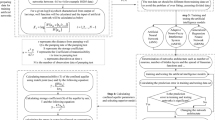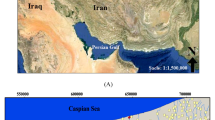Abstract
An artificial neural network (ANN) model is proposed for the simultaneous determination of transmissivity and storativity distributions of a heterogeneous aquifer system. ANNs may be useful tools for parameter identification problems due to their ability to solve complex nonlinear problems. As an extension of previous study—Karahan H, Ayvaz MT (2006) Forecasting aquifer parameters using artificial neural networks, J Porous Media 9(5):429–444—the performance of the proposed ANN model is tested on a two-dimensional hypothetical aquifer system for transient flow conditions. In the proposed ANN model, Cartesian coordinates of observation wells, associated piezometric heads and observation time are used as inputs while corresponding transmissivity and storativity values are used as outputs. The training, validation and testing processes of the ANN model are performed under two scenarios. In scenario 1, all the sampled data are used through the simulation time. However, in the scenario 2, there are data gaps due to irregular observations. By using the determined synaptic network weights, transmissivity and storativity distributions are predicted. In addition, the performance of the proposed ANN is tested for different noise data conditions. Results showed that the developed ANN model may be used in simultaneous aquifer parameter estimation problems.
Résumé
Un modèle de réseau neuronal artificel (ANN) est proposé pour la détermination simultanée des distributions des transmissivités et coefficients d’emmagasinement dans un système aquifère hétérogène. Les ANN peuvent constituer des outils utiles pour les problèmes d’identification de paramètres, grâce à leur capacité à résoudre des problèmes complexes non-linéaires. Dans la continuité de l’étude précédente—Karahan H, Ayvaz MT (2006) Forecasting aquifer parameters using artificial neural networks [Estimation des paramètres des aquifères par un réseau neuronal artificiel], J Porous Media 9(5):429–444)—les performances du modèle ANN proposé sont éprouvées sur un système aquifère bidimensionnel hypothétique en régime transitoire. Dans le modèle ANN proposé, les coordonnées cartésiennes des piézomètres, leurs niveaux piézométriques et les temps d’observation sont utilisés comme entrées, et les valeurs de transmissivité et coefficients d’emmagasinement correspondants comme sorties. Les procédures de mise en œuvre, de validation et de test du modèle ANN suivent deux scénarios différents. Dans le scénario 1, toutes les données acquises sont utilisées lors de la simulation, tandis que les données présentent des lacunes dues à l’irrégularité des observations dans le scénario 2. Les distributions des transmissivités et coefficients d’emmagasinement sont estimées à partir des pondérations du réseau synaptique. Les résultats ont démontré que le modèle ANN développé peut être utilisé dans le cas de problèmes simultanés d’estimation des paramètres des aquifères.
Resumen
Se propone un modelo de red neural artificial (RNA) para la determinación simultánea de las distribuciones del coeficiente de almacenamiento y de transmisividad de un sistema de acuífero heterogéneo. Las RNA pueden ser herramientas útiles en problemas de identificación de parámetros debido a su capacidad para resolver problemas complejos no lineales. Como parte de la ampliación de un estudio previo—Karahan H, Ayvaz MT (2006) Forecasting aquifer paramters using artificial neural networks [Predicción de parámetros de acuífero usando redes neurales artificiales], J Porous Media 9(5):429–444—se evalúa el desempeño del modelo propuesto RNA en un sistema acuífero hipotético de dos dimensiones en condiciones de flujo transitorio. En el modelo RNA propuesto se usan como entradas las coordenadas Cartesianas de pozos de observación, presiones piezométricas asociadas y tiempo de observación mientras que los valores correspondientes del coeficiente de almacenamiento y de transmisividad se usan como salidas. Se utilizan dos escenarios para los procesos de evaluación, validación y entrenamiento del modelo RNA. En el escenario 1 todos los datos muestreados se usan a través del tiempo de simulación. Sin embargo, en el escenario 2 existen brechas en los datos debido a observaciones irregulares. Mediante el uso de pesos de redes sinápticas determinados se predicen distribuciones de coeficiente de almacenamiento y de transmisividad. Además se evalúa el desempeño de la RNA propuesta para distintas condiciones de datos con ruido. Los resultados muestran que el modelo RNA puede ser usado en problemas de estimación simultánea de parámetros de acuíferos.












Similar content being viewed by others
References
Ayvaz MT, Karahan H, Aral MM (2007) Aquifer parameter and zone structure estimation using kernel-based fuzzy c-means clustering and genetic algorithm. J Hydrol 343(3–4):240–253
Bhattacharjya RK, Datta B (2005) Optimal management of coastal aquifers using linked simulation optimization approach. Water Resour Manage 19:295–320
Carrera J, Neuman SP (1986) Estimation of aquifer parameters under transient and steady-state conditions. 2. Uniqueness, stability and solution algorithms. Water Resour Res 22:211–227
Carrera J, Navarrina F, Vives L, Heredia J, Medina A (1990) Computational aspects of the inverse problem, computational methods in subsurface hydrology. Computational Mechanics, Southampton, UK, pp 513–522
Castanello G, Fanelli AM, Pelillo M (1997) An iterative pruning algorithm for feed forward neural networks. IEEE Trans Neural Networks 8(3):519–531
Cooley RL (1982) Incorporation of prior information on parameters into nonlinear regression groundwater flow models I: theory. Water Resour Res 18(4):965–976
Cooley RL (1985) A comparison of several methods of solving nonlinear regression groundwater flow problems. Water Resour Res 21:1525–1538
Coppola E, Szidarovszky F, Poulton M et al (2003) Artificial neural network approach for predicting transient water levels in a multilayered groundwater system under variable state, pumping, and climate conditions. J Hydrol Eng 8(6):348–360
Daliakopoulos IN, Coulibaly P, Tsanis IK (2005) Groundwater level forecasting using artificial neural networks. J Hydrol 309:229–240
Eppstein MJ, Dougherty DE (1996) Simultaneous estimation of transmissivity values and zonation. Water Resour Res 32(11):3321–3336
Feyen L, Gomez-Hernandez JJ, Ribeiro PJ, Beven KJ, De Smedt F (2003) A Bayesian approach to stochastic capture zone delineation incorporating tracer arrival times, conductivity measurements, and hydraulic head observations. Water Resour Res 39(5), no. 1126
Fienen MN, Kitanidis PK, Watson D, Jardine P (2004) An application of Bayesian inverse methods to vertical deconvolution of hydraulic conductivity in a heterogeneous aquifer at Oak Ridge National Laboratory. Math Geol 36(1):101–126
Garcia LA, Shigidi A (2006) Using neural networks for parameter estimation in ground water. J Hydrol 318(1–4):215–231
Gunduz O, Aral MM (2005) A dirac-delta function notation for source/sink terms in groundwater flow. ASCE J Hydrol Eng 10(5):420–427
Harrouni KE, Ouazar D, Wrobel LC, Cheng AH-D (1996) Aquifer parameter estimation by extended Kalman filtering and boundary elements. Eng Anal Boun Elem 19(3):231–237
Harrouni KE, Ouazar D, Wrobel LC, Cheng AH-D (1997) Groundwater parameter estimation by optimization and DRBEM. Eng Anal Boun Elem 19:97–103
Haykin S (1994) Neural networks. A comprehensive foundation. Macmillan, London
Hecht-Nielsen R (1987) Kolmogorov’s mapping neural network existence theorem. 1st IEEE Int. Joint Conference on Neural Networks 1987, San Diego, CA, IEEE, New York, pp 11–14
Hirose Y, Yamashita K, Hijiya S (1991) Back-propagation algorithm which varies the number of hidden units. Neural Networks 4:61–67
Karahan H, Ayvaz MT (2005) Groundwater parameter estimation by optimization and dual reciprocity finite differences method. J Porous Media 8(2):211–223
Karahan H, Ayvaz MT (2006) Forecasting aquifer parameters using artificial neural networks. J Porous Media 9(5):429–444
Kasabov NK (1996) Adaptable neuro production systems. Neurocomputing 13(2–4):95–117
Lingireddy S (1998) Aquifer parameter estimation using genetic algorithms and neural networks. Civil Eng Env Syst 15:125–144
Luk KC, Ball JE, Sharma A (2000) A study of optimal model lag and spatial inputs to artificial neural network for rainfall forecasting. J Hydrol 227(1–4):56–65
Maier HR, Dandy GC (2000) Neural networks for the prediction and forecasting of water resources variables: a review of modeling issues and applications. Env Mod Soft 15:101–124
Mayer AS, Huang CL (1999) Development and application of a coupled-process parameter inversion model based on the maximum likelihood estimation method. Adv Water Resour 22(8):841–853
Morshed J, Kaluarachchi JJ (1998) Application of artificial neural network and genetic algorithm in flow and transport simulations. Adv Water Res 22(2):145–158
Neuman SP (1980) A statistical approach to the inverse problem of aquifer hydrology. 3. Improved solution method and added perspective. Water Resour Res 16:331–346
Prasad KL, Rastogi AK (2001) Estimating net aquifer recharge and zonal transmissivity values for Mahi Right Canal Project area, India by genetic algorithm. J Hydrol 243:149–161
Shigidi A, Garcia LA (2003) Parameter estimation in groundwater hydrology using artificial neural networks. J Comp Civil Eng 17(4):281–289
Tsoukalas LH, Uhrig RE (1997) Fuzzy and neural approaches in engineering. Wiley, Chichester, UK
Woodbury AD, Ulrych TJ (2000) A full-Bayesian approach to the groundwater inverse problem for steady state flow. Water Resour Res 36(8):2081–2093
Zio E (1997) Approaching the inverse problem of parameter estimation in groundwater models by means of artificial neural networks. Progr Nucl Energy 31(3):303–315
Acknowledgements
The constructive reviews provided by three anonymous reviewers as well as the Associate Editor and Technical Editorial Advisor are greatly appreciated.
Author information
Authors and Affiliations
Corresponding author
Appendix: definitions of error indicators
Appendix: definitions of error indicators
Mean absolute error (MAE)
Modified coefficient of efficiency (E)
where h obs and h est are the observed and estimated hydraulic heads, \(\overline h _{{\text{obs}}} \) is the mean of the observed hydraulic heads, L is the number of values in the evaluation set.
Rights and permissions
About this article
Cite this article
Karahan, H., Ayvaz, M.T. Simultaneous parameter identification of a heterogeneous aquifer system using artificial neural networks. Hydrogeol J 16, 817–827 (2008). https://doi.org/10.1007/s10040-008-0279-0
Received:
Accepted:
Published:
Issue Date:
DOI: https://doi.org/10.1007/s10040-008-0279-0




